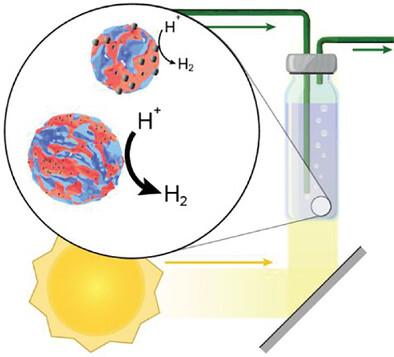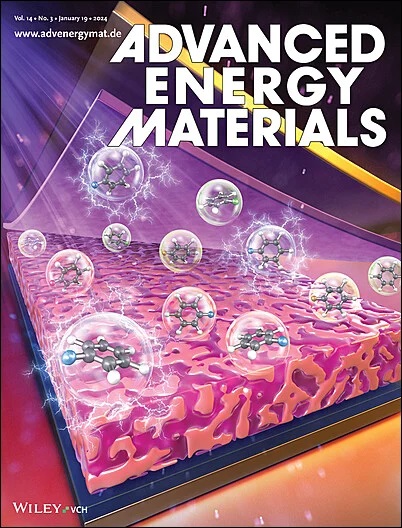用于太阳能制取 H2 的有机半导体纳米粒子上的共催化剂负载和形态控制的停滞光沉积技术
IF 26
1区 材料科学
Q1 CHEMISTRY, PHYSICAL
引用次数: 0
摘要
利用半导体光催化剂颗粒进行太阳能制氢通常需要助催化剂,但由于助催化剂通常是原位沉积,因此其成核/生长速度以及在寄生光吸收中的作用并不能很好地控制。本文介绍了一种停止光沉积-透析方法,该方法可对块状异质结有机半导体光催化剂纳米粒子上的铂(Pt)助催化剂负载和形态进行前所未有的控制。通过调节初始铂前驱体浓度和光沉积时间来控制铂负载和表面分布,然后通过透析去除未反应的铂前驱体。在典型的铂沉积条件下应用这种方法,在仅沉积 15.2 wt.% 铂的情况下,最大 H2 演化率为 140 mmol h-1 g-1(基于半导体质量)。此外,通过调整沉积条件,使小团簇和单原子的铂覆盖更均匀,而不是较大的铂氮化物,在铂负载量仅为 1.01 wt.%时,就能达到 30 mmol h-1 g-1 的 H2 演化峰值。与典型的铂光沉积(以铂为基础)相比,性能提高了八倍多,为优化性能提供了重要的启示。本文章由计算机程序翻译,如有差异,请以英文原文为准。

A Halted Photodeposition Technique Controls Co-Catalyst Loading and Morphology on Organic Semiconductor Nanoparticles for Solar H2 Production
Solar hydrogen production with semiconductor photocatalyst particles typically requires co-catalysts, but since co-catalysts are often deposited in situ, the rate of their nucleation/growth and role in parasitic light absorption are not well controlled. Herein a halted photodeposition-dialysis method is introduced that affords unprecedented control over platinum (Pt) co-catalyst loading and morphology on bulk heterojunction organic semiconductor photocatalyst nanoparticles. Pt loading and surface distribution are controlled by tuning the initial Pt precursor concentration and photodeposition time followed by removal of unreacted Pt precursor via dialysis. Applying this method with typical Pt deposition conditions gives a max H2 evolution rate of 140 mmol h−1 g−1 (based on semiconductor mass) with only 15.2 wt.% Pt deposited and suggests an optimum loading of <20 wt.% Pt, above which parasitic light absorption decreases the H2 evolution rate. Moreover, a peak H2 evolution >30 mmol h−1 g−1 is achieved with a Pt loading of only 1.01 wt.% by tuning the deposition conditions to favor a more uniform Pt coverage with small clusters and single atoms over larger Pt NPs. This represents a performance more than eight times higher compared to typical Pt photodepositions (based on Pt) and gives critical insights into optimizing performance.
求助全文
通过发布文献求助,成功后即可免费获取论文全文。
去求助
来源期刊

Advanced Energy Materials
CHEMISTRY, PHYSICAL-ENERGY & FUELS
CiteScore
41.90
自引率
4.00%
发文量
889
审稿时长
1.4 months
期刊介绍:
Established in 2011, Advanced Energy Materials is an international, interdisciplinary, English-language journal that focuses on materials used in energy harvesting, conversion, and storage. It is regarded as a top-quality journal alongside Advanced Materials, Advanced Functional Materials, and Small.
With a 2022 Impact Factor of 27.8, Advanced Energy Materials is considered a prime source for the best energy-related research. The journal covers a wide range of topics in energy-related research, including organic and inorganic photovoltaics, batteries and supercapacitors, fuel cells, hydrogen generation and storage, thermoelectrics, water splitting and photocatalysis, solar fuels and thermosolar power, magnetocalorics, and piezoelectronics.
The readership of Advanced Energy Materials includes materials scientists, chemists, physicists, and engineers in both academia and industry. The journal is indexed in various databases and collections, such as Advanced Technologies & Aerospace Database, FIZ Karlsruhe, INSPEC (IET), Science Citation Index Expanded, Technology Collection, and Web of Science, among others.
 求助内容:
求助内容: 应助结果提醒方式:
应助结果提醒方式:


